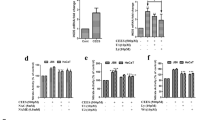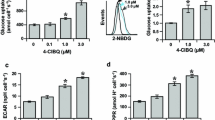Abstract
The purpose of this study was to investigate the effect of a superoxide-hydrogen peroxide (S-HP) imbalance of the superoxide dismutase manganese dependent (SOD2) gene, generated by paraquat and porphyrin exposure, on the keratinocytes cell line (HaCaT) oxidative metabolism. Paraquat acts increasing superoxide (O·−2) levels, while porphyrin increases hydrogen peroxide (H2O2) levels, acting as VV-SOD2-like and AA-SOD2-like molecules, respectively. First of all, HaCAT cells were treated with different concentrations of paraquat and porphyrin (1; 10; 30, and 70 μM) to determine the concentration of both that causes imbalance. After defining the concentration of paraquat and porphyrin (70 μM), a time curve was performed (1, 3, 6, and 24 h) to evaluate ROS production levels. Other oxidative parameters, such as nitric oxide (NO), lipoperoxidation (TBARS) and protein carbonyl, were evaluated after 24 h of incubation, as well as genotoxic analyses, apoptosis detection, and gene expression. Our findings revealed that paraquat exposure decreased cell viability, increasing lipoperoxidation, DNA damage, and apoptosis. On the other hand, porphyrin treatment increased cell viability and proliferation, ROS and NO production, triggering protein and DNA damage. In addition, porphyrin up-regulated Keap1 and Nrf2 gene expression, while paraquat decreased Nrf2 gene expression. In this sense, we suggested that the superoxide-hydrogen peroxide imbalance differentially modulates oxidative stress on keratinocytes cell line via Keap1-Nrf2 gene expression pathway.









Similar content being viewed by others
References
Bowman A, Birch-Machin MA (2016) Age-dependent decrease of mitochondrial complex II activity in human skin fibroblasts. J Invest Dermatol 136:912–919
Zhong JL, Edwards GP, Raval C, Li H, Tyrrell RM (2010) The role of Nrf2 in ultraviolet A mediated heme oxygenase 1 induction in human skin fibroblasts. Photochem Photobiol Sci 9:18–24
Tian FF, Zhang FF, Lai XD, Wang LJ, Yang L, Wang X, Singh G, Zhong JL (2011) Nrf2-mediated protection against UVA radiation in human skin keratinocytes. Biosci Trends 5:23–29
Schafër M, Werner S (2015) Nrf2—a regulator of keratinocyte redox signaling. Free Radic Biol Med 88:243–252
Deruy E, Gosselin K, Vercamer C, Martien S, Bouali F, Slomianny C, Bertout J, Bernard D, Pourtier A, Abbadie C (2010) MnSOD upregulation induces autophagic programmed cell death in senescent keratynocites. PLoS ONE 5:e12712
Kim YS, Vallur PG, Phaeton R, Mythreye K, Hempel N (2017) Insights into the dichotomous regulation of SOD2 in cancer. Antioxidants (Basel) 6:86
Bresciani G, Cruz IB, Paz JA, Cuevas MJ, Gonzalez-Gallego J (2013) The MnSOD Ala16Val SNP: relevance to human diseases and interaction with environmental factors. Free Radic Res 47:781–792
Kang SW (2015) Superoxide dismutase 2 gene and cancer risk: evidence from an updated meta-analysis. Int J Clin Exp Med 8:14647–14655
Li X, Shen M, Cai H, Liu K, Liu Y, Huang Z, Liang C, Deng X, Ye J, Zou Q, Li J (2016) Association between manganese superoxide dismutase (MnSOD) polymorphism and prostate cancer susceptibility: a meta-analysis. Int J Biol Markers 31:e422–e430
Minlikeeva AN, Browne RW, Ochs-Balcom HM, Marian C, Shields PG, Trevisan M, Krishnan S, Modali R, Seddon M, Lehman T, Freudenheim JL (2016) Single-nucleotide polymorphisms and markers of oxidative stress in healthy women. PLoS ONE 11:e0156450
Taufer M, Peres A, de Andrade VM, de Oliveira G, Sá G, do Canto ME, dos Santos AR, Bauer ME, da Cruz IB (2005) Is the Val16Ala manganese superoxide dismutase polymorphism associated with the aging process? J Gerontol A 60:432–438
Montagner FG, Sagrillo M, Machado MM, Almeida RC, Mostardeiro CP, Duarte MM, da Cruz IB (2010) Toxicological effects of ultraviolet radiation on lymphocyte cells with different manganese superoxide dismutase Ala16Val polymorphism genotypes. Toxicol In Vitro 24:1410–1416
Azzolin VF, Cadona FC, Machado AK, Berto M, Barbisan F, Dornelles EB, Glanzner WG, Gonçalves PB, Bica CG, da Cruz IBM (2016) Superoxide-hydrogen peroxide imbalance interferes with colorectal cancer cells viability, proliferation and oxaliplatin response. Toxicol In Vitro 32:8–15
Berto M, Bica CG, Sá GP, Barbisan F, Azzolin VF, Rogalski F, Duarte MMF, da Cruz IBM (2015) The effect of superoxide anion and hydrogen peroxide imbalance on prostate cancer: an integrative in vivo and in vitro analysis. Med Oncol 32:251
Schott KL, Assmann CE, Barbisan F, Azzolin VF, Bonadiman B, Duarte MMMF, Machado AK, da Cruz IBM (2017) Superoxide-hydrogen peroxide genetic imbalance modulates differentially the oxidative metabolism on human peripheral blood mononuclear cells exposed to seleno-L-methionine. Chem Biol Interact 273:18–27
Schott KL, Assmann CE, Teixeira CF, Boligon AA, Waechter SR, Duarte FA, Ribeiro EE, da Cruz IBM (2018) Brazil nut improves the oxidative metabolism of superoxide-hydrogen peroxide chemically-imbalanced human fibroblasts in a nutrigenomic manner. Food Chem Toxicol 121:519–526
Zhang R, Kang KA, Kim KC, Na SY, Chang WY, Kim GY, Kim HS, Hyun JW (2013) Oxidative stress causes epigenetic alteration of CDX1 expression in colorectal cancer cells. Gene 25:214–219
Bus Gibson JE (1984) Paraquat: model for oxidant-initiated toxicity. Environ Health Perspect 55:37–46
Esposti MD (2002) Measuring mitochondrial reactive oxygen species. Methods 26:335–340
Choi WS, Shin PG, Lee JH, Kim GD (2012) The regulatory effect of veratric acid on NO production in LPS-stimulated RAW264.7 macrophage cells. Cell Immunol 280:164–170
Jentzsch AM, Bachmann H, Furst P, Biesalski HK (1996) Improved analysis human of malondialdehyde in body fluids. Free Radic Biol Med 20:251–256
Singh NP, McCoy MT, Tice RR, Schneider EL (1988) A simple technique for quantitation of low levels of DNA damage in individual cells. Exp Cell Res 175:184–191
Maluf SW, Riegel M (2011) Citogenética humana, 1st edn. Artmed, Porto Alegre, pp 180–193
Sakai O, Uchida T, Roggia MF, Imai H, Ueta T, Amano S (2015) Role of glutathione peroxidase 4 in glutamate-induced oxytosis in the retina. PLoS ONE 10:e0130467
Barbisan F, Motta JR, Trott A, Azzolin V, Dornelles EB, Marcon M, Algarve TD, Duarte MMF, Mostardeiro CP, Unfer T, Schott KL, Cruz IBM (2014) Methotrexate-related response on human peripheral blood mononuclear cells may be modulated by the Ala16Val-SOD2 gene polymorphism. PLoS ONE 9:1–11
Day RM, Suzuki YJ (2006) Cell proliferation, reactive oxygen and cellular gluthatione. Dose Response 3:425–442
Zhang W, Liu HT (2002) MAPK signal pathways in the regulation of cell proliferation in mammalian cells. Cell Res 12:9–18
Kocak-Toker N, Giris M, Tulubas F, Uysal M, Aykac- Toker G (2005) Peroxynitrite induced decrease in Na+, K+-ATPase activity is restored by taurine. World J Gastroenterol 11:3554–3557
Zhang L, Li Q, Jia S, Huang Z, Luo Y (2018) Effect of different stunning methods on antioxidant status, in vivo myofibrillar protein oxidation, and the susceptibility to oxidation of silver carp (Hypophthalmichthys molitrix) fillets during 72 h post-mortem. Food Chem 246:121–128
Park S, Imlay JA (2003) High levels of intracellular cysteine promote oxidative DNA damage by driving the fenton reaction. J Bacteriol 185:1942–1950
Hu P, Wu T, Fan W, Chen L, Liu Y, Ni D, Bu W, Shi J (2017) Near infrared-assisted Fenton reaction for tumor-specific and mitochondrial DNA-targeted photochemotherapy. Biomaterial 141:86–95
Lu M, Ji J, Jiang Z, You Q (2016) The Keap1–Nrf2–are pathway as a potential preventive and therapeutic target: an update. Med Res Rev 36:924–963
Zhu H, Yan P, Wang L, Liu Y, Wen J, Zhang Q, Fan Y, Luo Y (2018) Protective properties of Huperzine A through activation Nrf2/ARE-mediated transcriptional response in X-rays radiation-induced NIH3T3 cells. J Cell Biochem 119:8359–8367
Funding
This study was supported by grants and fellowships from the following Brazilian governmental agencies: Fundação de Amparo à Pesquisa do Estado do Rio Grande do Sul (FAPERGS), Conselho Nacional de Desenvolvimento Científico e Tecnológico (CNPq), and Coordenação de Aperfeiçoamento de Pessoal de Nível Superior (CAPES).
Author information
Authors and Affiliations
Corresponding author
Ethics declarations
Conflict of interest
The authors declare that they have no conflict of interest.
Additional information
Publisher's Note
Springer Nature remains neutral with regard to jurisdictional claims in published maps and institutional affiliations.
Rights and permissions
About this article
Cite this article
Jobim, M.L., Azzolin, V.F., Assmann, C.E. et al. Superoxide-hydrogen peroxide imbalance differentially modulates the keratinocytes cell line (HaCaT) oxidative metabolism via Keap1-Nrf2 redox signaling pathway. Mol Biol Rep 46, 5785–5793 (2019). https://doi.org/10.1007/s11033-019-05012-1
Received:
Accepted:
Published:
Issue Date:
DOI: https://doi.org/10.1007/s11033-019-05012-1




